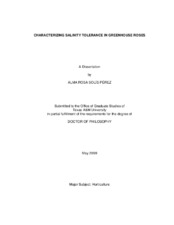| dc.description.abstract | Among ornamental plants, roses (Rosa L.) are considered the most
economically important, being among the most popular garden shrubs, as well
as the favorite cut flowers sold by florists. In the past roses have been classified
as fairly salt-sensitive, however, recent nutrition studies suggest that they may
actually tolerate moderate to relatively high salinities. The general objective of
this research was to reassess the limits of tolerance to salinity of roses and the
influence of the rootstock used, to determine the ameliorative properties of
supplemental Ca2+ on the response to salt stress, and to establish the influence
of Na+- and Cl--counter ions on the detrimental effects caused by these
salinizing elements.
The NaCl or NaCl-CaCl2-salinity tolerance limit for greenhouse roses,
although greatly influenced by the rootstock, was between 12 and 15 mmol.L-1.
Plants grafted on ?Manetti? sustained their productivity/quality characteristics for
longer time periods, tolerated greater salinity concentrations, and accumulated
less Cl- and Na+ in leaves of flowering shoots than those grafted on ?Natal Briar?,
confirming the greater ability of the former rootstock to tolerate salt stress.
Supplementing the saline solution with 0-10 mmol.L-1 Ca2+ (as CaSO4) did
not alleviate the harmful effects caused by NaCl-salt stress (12 mmol.L-1) on the
productivity and quality responses of roses.
The detrimental effects caused by Na- and Cl-based salinity were greatly
influenced by the composition of the salt mixtures (i.e. their counter ions). Sodium sulfate and CaCl2 were the least harmful salts; NaCl had intermediate
effects, while NaNO3 and KCl were the most deleterious. Among the most
distinguishable effects caused by the more toxic Na+ and Cl- counter ions were
lower osmotic potential (piSS) and greater electrical conductivity (ECSS) of the
salinized solutions, markedly increased uptake and/or transport of either Na+ or
Cl- to the flowering shoot leaves, and altered uptake and/or transport of other
mineral nutrients.
Computations of the saline solutions? chemical speciation revealed that
salts containing divalent ions had lower ionization and exhibited greater ion
associations compared to monovalent ion salts, rendering a lower number in
free ions/molecules in solution which caused greater SS and lower ECSS in
those solutions. | en |


